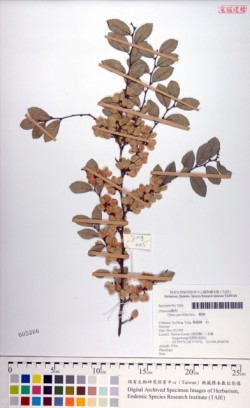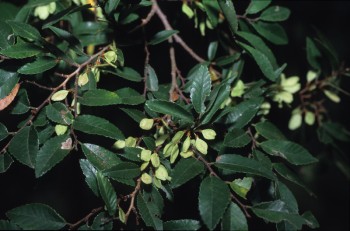TELDAP Collections
| Information Explosion: The Taiwan Wild Plant Database |
|
Article provided by the Digital Archives Request-for-Proposals Project, a subsidiary of the Taiwan Digital Archives Expansion Project The specimen (upper image) and the eco-photo (lower image) of Ulmus parvifolia Jacq.
Species Surveys and Databases
All living creatures co-exist in a network of interdependent relationships. The “interdependence of myriad creatures,” a huge and unfathomable phenomenon of life, comprises numerous puzzles that remain unsolved by science. For scientists, it is particularly difficult to take inventory of all the world’s species. At present, taxonomists have identified, named, described, and classified approximately 1.8 million species, which may seem like a large number but represents only an estimated 5%-10% of all living organisms. Thus, it is impossible to fully understand what “myriad creatures” truly means or to imagine how many organisms exist on earth.
Many species are going extinct before they can be identified and described, owing in part to the slow progress in taxonomic research and the deterioration of the environment through rapid industrial development. This has caused gaps in our knowledge about the inter-relationships between species, which poses difficulties for making environmental predictions and conservation planning. There is an urgent need to conduct surveys of living species from around the world to keep up with the rate of extinction. The Earth Summit held in Brazil in 1992, which hosted the signing of the Convention on Biological Diversity, served as a launch pad for the implementation of new species surveys. The provisions of the convention require all signatories to work toward the goal of a more complete taxonomy, whether by conducting nationwide surveys, compiling species lists for animals and plants, or creating government species databases. The international treaty has won widespread praise from professionals from diverse fields, as it provides a basis for effective global action on sustainable conservation and biological diversity.
All signatory countries, legally bound under the convention, have funded research initiatives to investigate the current status of living creatures. Since these projects are government-funded, their results are regarded as public property that can be openly accessed. The research results have been accruing over time, connecting the past, present, and future of species on earth. Considering our ethical obligations to all other species on Earth, the information recorded should be freely transmitted across national borders and made available to all people. However, is it possible to effectively share such a tremendous amount of research data? Now that information can be spread via the Internet and stored in massive databases, this question is no longer cause for concern. Dedicated to the principle that research data must be open to the public, many scientists share a common vision of creating a website that brings global species databases to one central location. Such a website would enable free access to the latest updates on biodiversity data. This data would mostly be the basic type of information required for taxonomic identification of living organisms, namely species checklists and digital images of specimens.
The Global Biodiversity Information Facility (GBIF), established in 2001, is an international organization that works to integrate digital biodiversity data drawn from all over the world, whereas the Taiwan Biodiversity Information Facility (TaiBIF) was founded to compile Taiwan-specific data. The Taiwanese database includes species checklists, directories of local professionals, species images, descriptions of endemic species and invasive species, distributions of terrestrial and marine organisms, biodiversity literature, geographic data, as well as information on relevant institutions, projects and publications. Currently, Taiwan’s biodiversity data can be accessed anywhere through the GBIF data portal.
The Database: Collective Wisdom and Collaboration
The species database was created to facilitate access, sharing, and integration of all biodiversity data. The database can be used to help researchers reduce the time and money spent on redundant data construction, and will also allow users to be able to quickly access data. Identifying plant specimens was once an arduous task, considering that in the past researchers had to make trips to several different herbaria to consult card catalogs and rummage through botany cabinets until they found the plant specimens essential to their studies. The online database means researchers can avoid these unnecessary trips while still getting the pertinent information.
For professional taxonomists or parataxonomists, the identification and comparison of species can now be accomplished with the use of computers and networks that provide free and unrestricted access to original descriptive literature on species and 3D images of specimens.
The image of the wild plant presented here is shown as an example of how the database allows for freedom of information and species identification outside the confines of laboratories. The species database is the result of collective wisdom and collaborative efforts. In fact, the science of biological taxonomy receives a constant stream of input from non-professionals, giving it the potential to contribute to the spread of knowledge on a much wider level.
In the digital age, how do volunteers from the general public in Taiwan devote themselves to the accumulation of biodiversity data? Both the promotion efforts of the Endemic Species Research Institute and the creation of the Taiwan Wild Plant Database have led to a better understanding of the public’s involvement in the dissemination of knowledge in the digital environment.
The Endemic Species Research Institute’s Mission
The Endemic Species Research Institute, located in Jiji township of Nantou country, is subordinate to the government’s Council of Agriculture. It was founded in July of 1992, when Taiwan began on its path toward the improvement of global environmental conservation.
In light of environmental groups’ many protests against deforestation practices in Taiwan, a logging ban was enacted in 1988 and the forestry bureau was transformed into a public-sector organization. In 1989, Taiwan passed the Wildlife Conservation Act. In 1992, British authorities filed complaints over the use of rhino horns and tiger bones in traditional Chinese medicine, contending that the commercial trading of such animal tissues in Taiwan violated the Convention on International Trade in Endangered Species of Wild Fauna and Flora (CITES, also known as the Washington Convention). Due to the complaint, the United States imposed trade sanctions on Taiwan under the Pelly Amendment in 1994, which was immediately followed by a sweeping amendment made to the Wildlife Conservation Act in Taiwan. The Environmental Impact Assessment Act, which significantly affected environmental policy in Taiwan, was also passed the same year. Prior to this, Taiwan had long remained outside multilateral environmental agreements since its exit from the United Nations in the 1970s. It was not until Taiwan faced mounting pressure in 1992-1994 to comply with the Washington Convention that it began to develop a heightened awareness of environmental trends around the world. The aforementioned Convention on Biological Diversity was established by the United Nations one month before the foundation of the Endemic Species Research Institute .
The Endemic Species Research Institute, founded at a time of urgency for biodiversity conservation, has remained committed to its mission of investigating Taiwan’s fauna, flora, and peculiar ecosystems as well as promoting ecological education. One of its key services is to conduct educational seminars aimed at the general public. In the 17 years since its inception, the institute has conducted species surveys all over Taiwan and on its outlying islands, and has compiled lists of native plants, which contain more than 23,000 specimens belonging to 224 families and 3,064 species. The lists account for approximately three-fourths of Taiwan’s native plants. In addition, a large number of eco-photos are taken during surveys. The institute’s film library has preserved more than 20,000 photos and 80 educational videos, which provide information about animals, vascular plants, bryophytes, microscopic images of plant cells, fungi, and more. This wealth of information makes up the content of the institute’s website and database.
The Content and Features of Taiwan Wild Plant Database
Since 1999, the Endemic Species Research Institute has been digitizing its ever-increasing collection of data on native fauna and flora. All of the digital survey information can be accessed through its Taiwan Wild Plant Database, which in turn provides a great depth and breadth of species knowledge for all users. Currently, the database contains 24,440 entries of botanical data uploaded from Taiwan Biodiversity Information Facility. The Taiwan Wild Plant Database was significantly expanded in 2006 to include 6,390 digital images of plant specimens and 1,011 eco-images of Taiwan’s wild plants (totaling 325 plant species). As of 2007, the database contained over 7,500 digital images documenting moss and vascular plants in their habitats, plant specimens, and microscopic views of plant cells, along with new ecological films and photos of wild animals, bryophytes, and the microscopic structure of plant cells. The rich collection of information accessible through this database is one of the most comprehensive and complete in Taiwan.
Unlike similar databases, the Taiwan Wild Plant Database includes a “membership zone,” which is open to all volunteer contributors once they meet the program’s criteria. By participating in ESRI ecological training workshops, amateur volunteers devoted to wildlife and habitat conservation are taught to use tools to collect and process data that can add to biodiversity knowledge. The workshops provide the public with education, and also help develop the expertise of local enthusiasts. Having this team of enthusiasts add to work being done by professionals helps compensate for the high rates of species extinction.
The ever-growing digital information stored in the Taiwan Wild Plant Database holds different layers of meanings and perspectives. The database has now become part of the Global Biodiversity Information Facility, and is thus capable of exchanging biodiversity information with the global community. Because the database was established under a project for the Taiwan e-Learning and Digital Archives Program, its digitized content is viewed as a vital part of a national archived collection. From the ESRI’s perspective, undertaking this digitization work involves a thorough inventory of its amassed resources, which will facilitate ecology research as well as support its mission to promote ecological education.
1 Shao Kwangtsao,〈The Evolution of Systematics〉,Informatics@TaiBIF,28th October, 2009. Visit Date:2010/05/30:http://taibif.org.tw/informatics/?p=31
|














